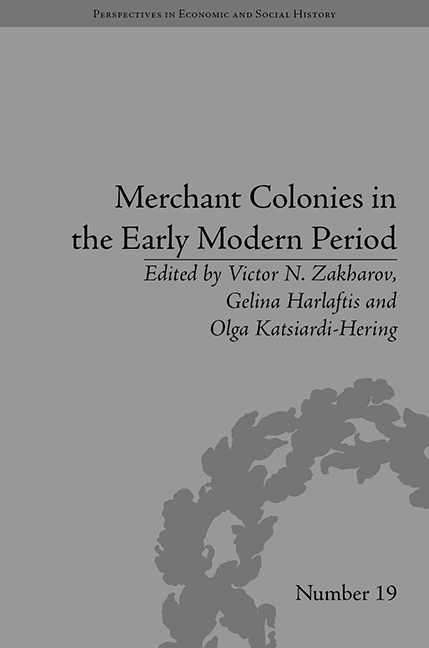Book contents
- Frontmatter
- Contents
- List of Figures and Tables
- List of Contributors
- Introduction
- 1 Early Modern English Merchant Colonies: Contexts and Functions
- 2 German and Italian Merchant Colonies in Early Modern England
- 3 Dynamism and Integration of the North European Merchant Communities in French Ports in the Eighteenth Century
- 4 Opportunity and Legislation: How the Armenians Entered Trade in Three Mediterranean Ports
- 5 Russian Merchant Colonies in Seventeenth-Century Sweden
- 6 Foreign Merchant Communities in Eighteenth-Century Russia
- 7 Greek Merchant Colonies in Central and South-Eastern Europe in the Eighteenth and Early Nineteenth Centuries
- 8 Community for Commerce: An Introduction to the Nezhin Greek Brotherhood Focusing on its Establishment as a Formal Institution in the Years Between 1692 and 1710
- 9 Entrepreneurship at the Russian Frontier of International Trade. The Greek Merchant Community/Paroikia of Taganrog in the Sea of Azov, 1780s–1830s
- Notes
- Index
8 - Community for Commerce: An Introduction to the Nezhin Greek Brotherhood Focusing on its Establishment as a Formal Institution in the Years Between 1692 and 1710
- Frontmatter
- Contents
- List of Figures and Tables
- List of Contributors
- Introduction
- 1 Early Modern English Merchant Colonies: Contexts and Functions
- 2 German and Italian Merchant Colonies in Early Modern England
- 3 Dynamism and Integration of the North European Merchant Communities in French Ports in the Eighteenth Century
- 4 Opportunity and Legislation: How the Armenians Entered Trade in Three Mediterranean Ports
- 5 Russian Merchant Colonies in Seventeenth-Century Sweden
- 6 Foreign Merchant Communities in Eighteenth-Century Russia
- 7 Greek Merchant Colonies in Central and South-Eastern Europe in the Eighteenth and Early Nineteenth Centuries
- 8 Community for Commerce: An Introduction to the Nezhin Greek Brotherhood Focusing on its Establishment as a Formal Institution in the Years Between 1692 and 1710
- 9 Entrepreneurship at the Russian Frontier of International Trade. The Greek Merchant Community/Paroikia of Taganrog in the Sea of Azov, 1780s–1830s
- Notes
- Index
Summary
It was in the border town of Nezhin, ‘Nizhna’ in the Greek sources, in what is today north-eastern Ukraine, that the ‘Brotherhood of the Greeks’ with its religious and trading privileges and its arbitration court was established in the closing years of the seventeenth century.
The members of this ‘Brotherhood of the Greeks’ called themselves ‘Romioi’, denoting that they were Orthodox Christians of the Ottoman Empire; theirs was thus ‘the Brotherhood of the Romioi of Nizhna’ or alternatively ‘of Kazakia’. In the Russian and Ukrainian texts of the time these Romioi are called ‘Greeks’ or ‘Greki’. It is only in very specific contexts, and towards the end of the century, that the term ‘Hellene’ is used with respect to this particular group. Though it is true that many members of the ‘Brotherhood’ spoke Greek only as a second language, it should be noted that the official language of their communal institutions, both secular and religious, was Greek. Following Troian Stoianovich's characterization of these his ‘conquering’ merchants, this should be considered just as much a Brotherhood of the Balkan Orthodox as a Brotherhood of Greeks, though arguably the distinction would have been lost on most of its members.
Nezhin was far from the precarious coast, and did not lie on any of the significant fluvial arteries linking Ukrainian territories with the Black Sea littoral.
- Type
- Chapter
- Information
- Merchant Colonies in the Early Modern Period , pp. 141 - 156Publisher: Pickering & ChattoFirst published in: 2014

